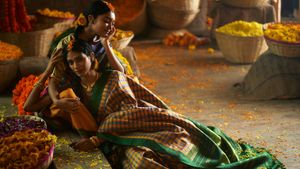The saree definitely is a timeless attire with a long history. Distinctive to Indian culture, handloom sarees are woven by hand, textured and patterned with remarkable creativity yet simplicity. There are stunning designs of various types of handloom sarees which are produced in different states and have their own unique features. With a distinct identity of its own, a saree radiates sheer elegance and sophistication. Here we explore some of the different types of handloom sarees which will definitely inspire you to buy a couple for your own wardrobe.
10 handloom sarees from across India you should know about
1. Baluchari
Owing to its origins in the Murshidabad district of West Bengal, Baluchari sarees are spun from the purest tussar silk. Baluchari sarees are mainly known for their mythological designs, inspired by episodes in Ramayana and Mahabharata, and various local folklore. Baluchari sarees are weaved in three patterns, which are the Resham baluchari, Meenakari baluchari and swarnachari. Resham balucharis are the simplest baluchari, with a single colour used for weaving the entire pattern. Meenakari baluchari is where two or more colours are used for the weaving, and swarnachari is where silver threads are woven into the brocades.
2. Ikat
With its intricate designs and motifs, Ikat is spun on cotton as well as silk. With its origins in Odisha, Ikat has been mastered by the Meher and the Bhulia community of weavers. With its simple yet sophisticated designs, one is bound to radiate elegance while wearing an Ikat saree.
3. Chanderi
Deriving its name from a small place situated in Madhya Pradesh, Chanderi sarees are best suited for summer. These sarees are lightweight and have a glossy, transparent texture. Chanderi sarees often come with a huge amount of golden zari work. Quite magnificent in its appearance, Chanderi sarees are sure to make you look like a diva.
4. Bandhani
Very much in demand nowadays, and used in a variety of products other than just sarees, Bandhani is the weaving style practised in Gujarat and Rajasthan, as well as in some parts of Uttar Pradesh. Usually made with cotton and silk fabrics, bandhani is a technique of dyeing fabrics by binding them firmly. ‘Bandh’ literally means to tie. With the vibrant prints available in several colours, Bandhani sarees have definitely stood the test of time.
5. Muga Silk
The most valued silk of India, Muga silk is a type of Assam silk. Featuring intricate threadwork, Muga silk sarees are extremely durable. Exclusively reared and produced in Assam by silkworm Antheraea, these sarees are exclusive and often customised. Known for its rich texture and elegant look, Assamese women often wear Muga silk sarees on special occasions.
6. Tussar Silk
Tussar silk is a type of silk saree made from a type of wild silk. Tussar silk is considered more textured and is quite popular and valued for its natural golden colour. Extremely lightweight, with a feel of luxury, Tussar definitely drapes around a woman like a dream and gives an extremely sophisticated and dignified look.
7. Sambalpuri Silk
Produced in Odisha, Sambalpuri designs are woven and handmade with pure silk. These sarees have a soft texture and drape around beautifully. Designed in various motifs, these are a type of traditional handwoven ikat which are extremely comfortable.
8. Organza
Organza sarees are thin and with simple weaves on sheer fabric, traditionally made from silk. Organza sarees are extremely trendy and elegant. Delicate yet durable, organza sarees are extremely lightweight and have an unparalleled finesse.
9. Tant
Tant sarees are traditional Bengali sarees woven from cotton threads. These sarees are known for their lightness and transparency. Characterised by a thick two to four-inch border and a decorative pallu, these sarees are made for daily use. They come in a variety of floral and artistic motifs and are extremely affordable.
10. Pochampally
Originating from Bhoodan Pochampally, in Telangana. These sarees have traditional geometric patterns with intricate designs and are made from the Paagadu Bandhu style of dyeing. These sarees come in beautiful zari work and borders and have durable vibrant colours.
Disclaimer: The details mentioned throughout this blog are sourced from publicly accessible platforms. At Zeezest, we intend to share factual and verified information. Should there be any inconsistencies or variances in the information provided, please understand that these are entirely unintentional and not meant to mislead


_1696103816439_thumb_1200.jpeg?w=3840&q=75)

